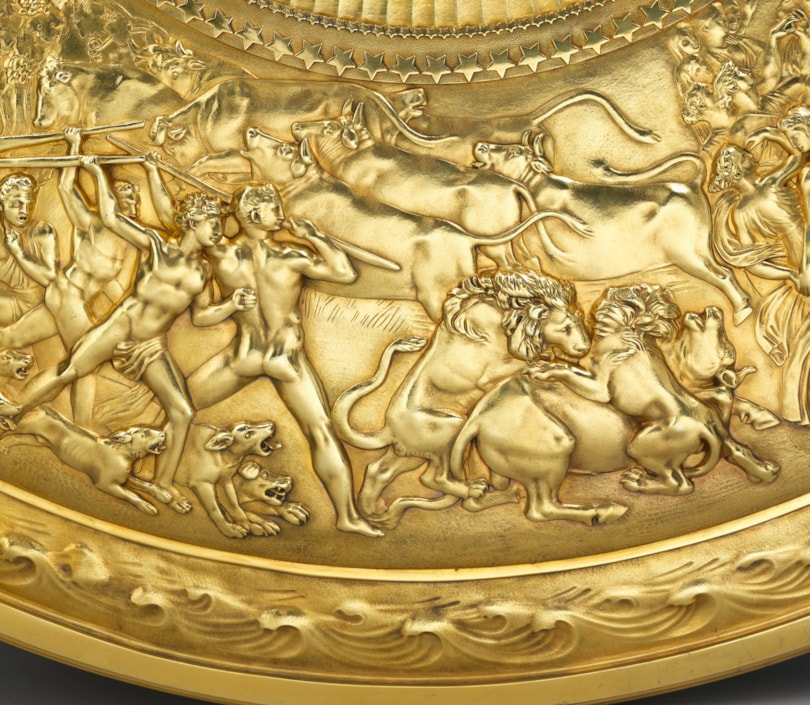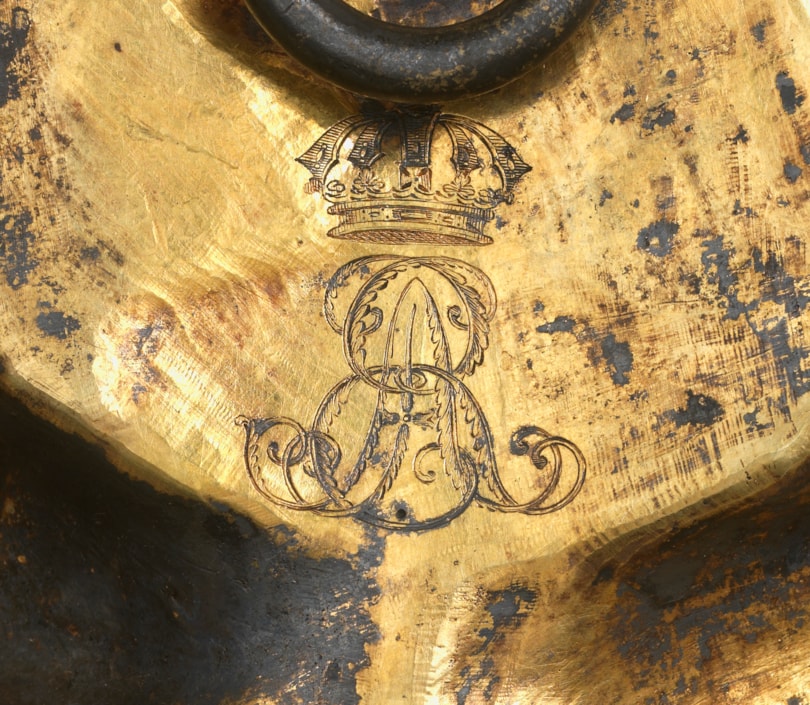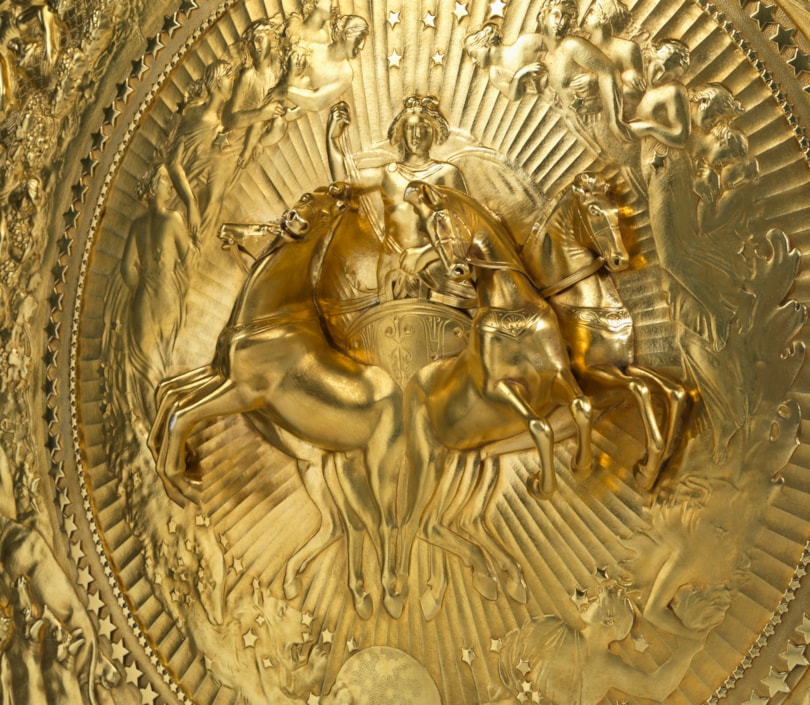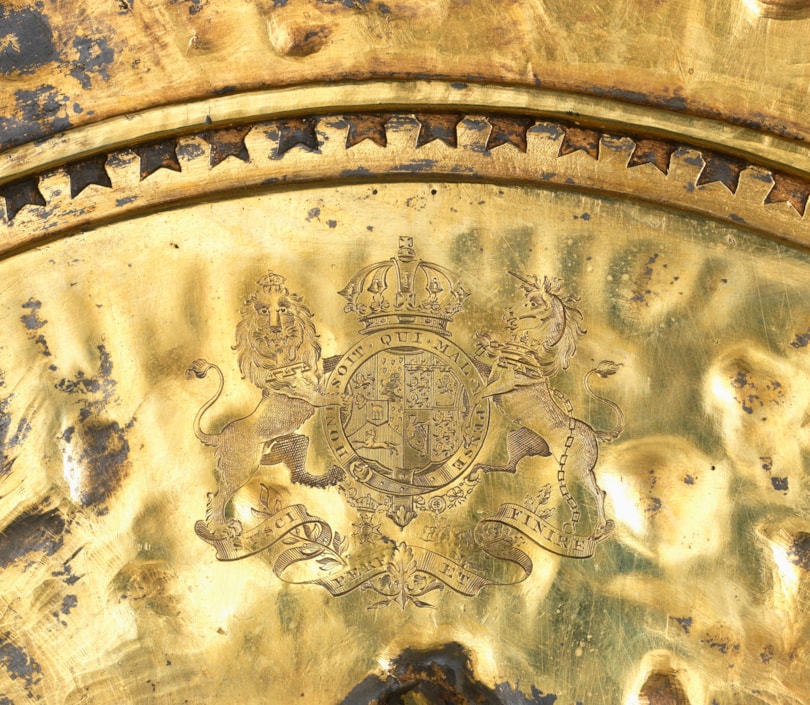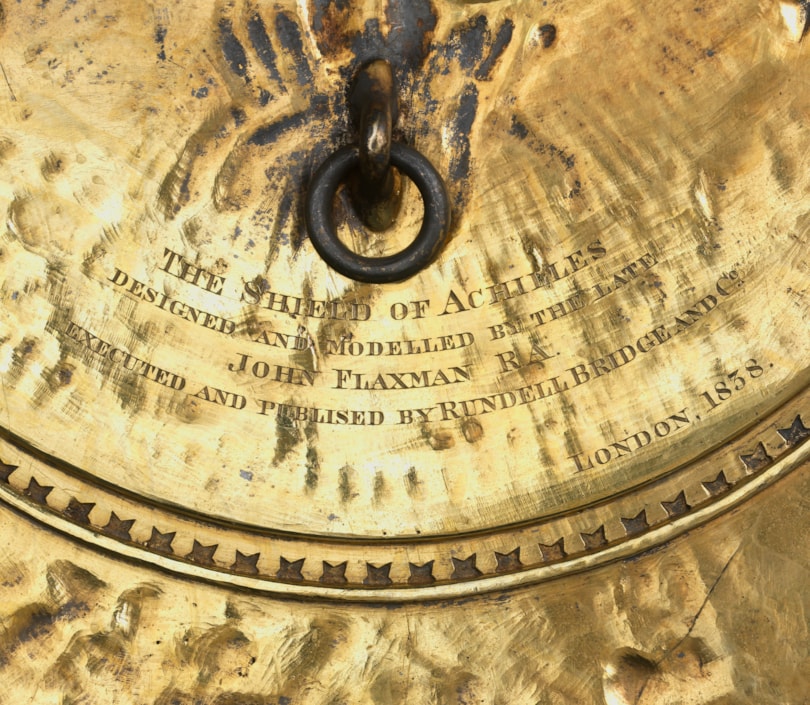The circular shield is cast and chased after the design by John Flaxman with scenes from the eighteenth book of Homer’s Iliad. The reverse has four rings at the rim and centre for attaching leather straps. Engraved on the reverse with a cypher, coat of arms and with the inscription:” THE SHIELD OF ACHILLES/ DESIGNED AND MODELLED BY THE LATE/ JOHN FLAXMAN R.A./ EXECUTED AND PUBLISHED BY RUNDELL BRIDGE AND CO./ LONDON 1838”.
The spectacular shield of Achilles is the supreme example of early nineteenth-century English silver and is a triumphant collaboration between the great firm of Rundell and Bridge and the leading designer John Flaxman. “The silver-gilt Shield of Achilles, designed and modelled by one of the greatest English sculptors of the regency, is an outstanding instance of a synthesis of the fine and decorative arts. The designer, John Flaxman was the most illustrious of the Royal Academicians associated with Rundell, Bridge & Rundell ...” (Shirley Bury and Michael Snodin, ‘The Shield of Achilles by John Flaxman R.A., Sotheby’s Art at Auction 1983-4, 1984, pp. 274-83).
Flaxman was “the most famous British sculptor and the brightest star in the Rundell & Bridge firmament” (Christopher Hartop, see Literature, p. 104). From 1805 he had been supplying the firm with drawings of figures and friezes which were then employed on various designs for large pieces of silver such as wine coolers and vases. He actually modelled only one piece for the firm, however, the shield of Achilles. Flaxman’s design is an interpretation of the shield wrought for Achilles by the god Hephaestus at the request of Thetis after Achilles lost his armour which he had lent to Patroclus; it having been seized as the spoils of war by Hector.
“Then first he formed the immense and solid shield
Rich various artifice emblazed the field”
Alexander Pope’s translation of the Iliad
The Renaissance concept of massive display chargers or shields decorated with scenes celebrating great military triumphs had long been out of fashion but was revived by Philip Rundell and John Bridge by 1810, the year in which Flaxman submitted his first designs for this great project. It was to be another seven years before the design was completed to his satisfaction. In 1817 he made the model for the shield himself which was then cast in plaster. The artist Sir Thomas Lawrence was also presented with a plaster version of the shield. He admired and treasured it to the point he decided to mention Flaxman’s masterpiece in his eulogium to the latter describing it as “that Divine Work, unequalled in the combination of beauty, variety and grandeur, which the genius of Michael Angelo could not have surpassed”.
Three or possibly more bronze versions were made and finished by the chaser William Pitts junior and finally in 1819 a silver version was made. It was this shield which was then gilded and sold to George IV in 1821 to form the centrepiece for the buffet of plate at his coronation banquet. Flaxman was initially paid one hundred guineas for ‘4 models and 6 drawings’ and in 1817 he received £200 on account and a further £525 in the following year (John Culme, Important Gold and Silver, sale, Sotheby’s, London, 3rd May 1984, lot 124).
Five silver-gilt shields in all were made. The first, mentioned above, which is in the Royal Collection and a further example which was acquired by Frederick Augustus, Duke of York and is now in the collections of the Huntington Library and Art Gallery, San Marino, California; both of these shields are marked for 1821-22. Two further shields both marked for 1822-23 were sold to Hugh Percy, 3rd Duke of Northumberland in 1822 for £2,100 and to William Lowther, 2nd Earl of Lonsdale in 1823 and are in the collections of His Excellency Mohamed Mahdi Altajir and the National Trust at Anglesey Abbey respectively. The present shield which is marked for 1823-24 was sold to Ernst Augustus, Duke of Cumberland and later King of Hanover and for many years its existence was overlooked.
The reason for this shield being ‘lost’ springs from the belief that only four were actually made and in part this error must arise from the description by the German Ludwig Schorn of his visit in 1826 to the workshops of Rundell’s: “to the silversmiths Rundell & Bridge who kept a splendid shop not far from St. Paul’s on Ludgate Hill. Here I was shown the shield of Achilles cast in silver and chased after a plaster model which Flaxman had executed to the King’s commission ... the shield has been cast four times in silver for the king, the Duke of York, the Duke of Northumberland and Lord Lonsdale. Gilded the article costs £2000, ungilded £1900” (exhibition catalogue, see Literature, pp. 30-31). This gives the impression that only four shields were made although Schorn must have been looking at the fifth example which is the one sold to the Duke of Cumberland. In 1911 E. Alfred Jones stated that an example had been made for the King of Hanover: “A shield of exactly the same design and of equal size but two years later in date is in the possession of the duke of Cumberland”. Jones must have seen the shield as he makes it clear in the acknowledgements that he was given access to the Hanoverian royal collection. Christopher Hartop realised that there were five shields but did not know of the whereabouts of the Cumberland shield in 2005.
The shields were not made to a commission but were a speculative exercise and it would seem that this shield remained in Rundell’s shop on display as a magnificent testament to the supreme skills of their craftsmen and designers. The company, who were excellent self publicists, would have used the shield as an advertisement to maximum advantage. It was probably sold to the Duke of Cumberland after his accession to the throne of Hanover in 1837 and probably in 1838 as attested by the inscription on the reverse of the shield. The arms must have been engraved after 1839 as they incorporate the Order of St. George of Hanover which was instituted by Ernst Augustus in April 1839. The new Hanoverian monarch acquired massive quantities of plate in 1838 amounting to over 180 kilos and including six thirteen light candelabra and two centrepieces. This great display of plate would have played an important role in the establishment of the new king and the image of splendour that he wished to create for himself. Unlike his brother George IV, he did not acquire plate for the specific occasion of his coronation.
The shield appears in a photograph of the Hanoverian royal plate on display in Vienna in 1868. There is no record of the sale of the shield but much of the Hanoverian royal plate was disposed of in 1923 after the death of Crown Prince Ernst Augustus II by the dealers and auctioneers Samuel and Max Glückselig of Vienna and Crichton Brothers of London and it is probable that it was sold at this time.
Flaxman in his design adhered closely to the description given by Homer. The design of the shield revolves around the central figure of the Apollo is his chariot of the sun. The frieze, arranged in a succession of groups, depicts the marriage procession and banquet, the quarrel and judicial appeal, the siege and ambuscade and military engagement, the harvest, the vintage, the shepherds defending their herds of cattle from the attack of lions and a Cretan dance. The great stream of the ocean is represented by the surrounding border. Flaxman’s drawings for the shield are in the collections of the British Museum and what is believed to be the original cast for the shield is in the Sir John Soane Museum, London. Allan Cunningham (The Lives of the most eminent British Painters, Sculptors, and Architects, 1833, vol. III) suggested that Flaxman used a translation of the Iliad when working on his design although this was contradicted by Maria Denman, Flaxman’s sister-in-law, who insisted that he had worked from the original Greek text.
Ernest Augustus Duke of Cumberland and King of Hanover (1771-
1851); thence by descent in the Hanoverian royal family until sold, probably in 1923.
Josef van Mierlo, circa 1940 and thence by descent in the van Mierlo family, Essen, Belgium.
Sotheby's London, 2007.
Koopman Rare Art.
Private Collection.
E. Alfred Jones, The Gold and Silver of Windsor Castle, 1911, p. XLVII
Exhibition catalogue: John Flaxman, R.A., 1979, pp. 30-31
Christopher Hartop, Royal Goldsmiths: The Art of Rundell & Bridge 1797-1843, 2005, pp. 99-118




































































